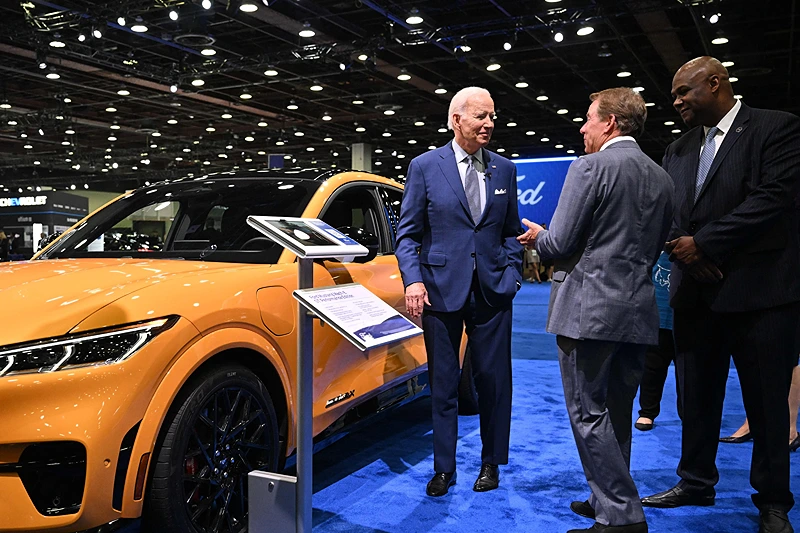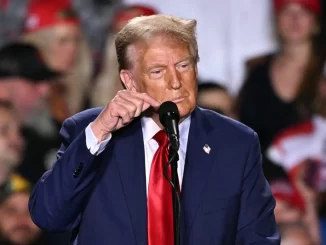

OAN Brooke Mallory
UPDATED 12:45 PM – Friday, April 7, 2023
The Biden administration is on course to propose the strictest car pollution regulations ever made in the United States, but will refrain from imposing an electric vehicle (EV) mandate or outlawing gas-powered vehicles.
The proposed regulations for cars and light trucks are anticipated to regulate the tailpipe emissions of carbon dioxide, nitrogen oxide, and other pollutants from vehicles produced for model years 2027 through 2032. They are scheduled to be unveiled on Wednesday in Detroit.
The plan was described by an insider who knew what the proposal consisted of, but asked to remain anonymous as it has not yet been made public.
American carmakers have begged for regulations that last only a few years, but EV producers like Tesla Inc. think the administration should use increased federal investments in charging infrastructure and battery development to press for even tighter regulations.
The policy, which requires using hundreds of billions of dollars in clean energy incentives provided by the Inflation Reduction Act, is one of many that the Biden administration is employing to crack down on transportation and power pollution that he said contributes to global warming.
Additionally, new limits for greenhouse gas emissions from heavy-duty trucks and power plants are expected to be proposed by the Environmental Protection Agency (EPA), which is authoring the new performance-based criteria on Wednesday, and even more later this month.
“The future of the auto industry is electric…There’s no turning back,” Biden said during a visit to a Ford EV center in Michigan.
In order for the U.S. to reach its goal under the Paris Agreement of reducing greenhouse gas emissions by at least 50% from 2005-levels by the end of the decade, and to achieve Biden’s goal of having half of all new vehicle sales be electric models by 2030, limits on automotive pollution would be essential.
Environmentalists argued that strict tailpipe regulations are required to prevent reversals, despite the fact that American carmakers like General Motors Co. and Ford Motor Co. have optimistic and detailed forecasts for EV sales.
“There has to be continuous pressure for improvement,” said Dan Becker, director of the Center for Biological Diversity’s Safe Climate Transport Campaign.
Since the proposed rules are still being reviewed by many agencies, the EPA chose not to comment on the details. The agency said in a statement that it is creating new guidelines to build on Biden’s achievements in the clean energy sector and “support the transition to a zero-emissions transportation future, protecting people and the planet.”
The EPA does not specify a particular technology for achieving the targets, but rather, the vehicle requirements are said to be performance-based and take the form of maximum permitted emissions per mile.
Nevertheless, electric vehicles are viewed as a crucial component in meeting the standards.
Environmentalists, public health experts, and proponents of electric vehicles have pressed the administration to ensure that the rules for vehicles with model years 2030 become 75% stricter than those controlling 2021 models.
Britt Carmon, a senior campaigner with the Natural Resources Defense Council, said that strong standards are “incredibly important” for providing market signals to expedite electric vehicle emissions and achieving necessary emission reductions down the road.
However, the EPA is prepared to turn down some environmentalists’ proposals in order to adopt and establish vehicle standards up until 2035. The trajectory for EVs and emission reductions rests on factors outside the control of the automakers, including investments in charging infrastructure and the supply of essential minerals.
Some critics shot down the regulations for increasing consumer costs amid already high inflation.
“NHTSA’s new fuel economy standards will only add to the cost of new cars, depriving people of safe, affordable vehicles, at a time when they are already struggling,” said Representative Cathy McMorris Rodgers (R-Wash.), the current chair of the House Energy and Commerce Committee.
According to Alliance for Automotive Innovation, the change will demand a “massive, 100-year change to the US industrial base,” and the statutes should be based on “a clear-eyed assessment of market readiness.”
The EPA proposal is expected to strengthen restrictions on vehicle pollution that contributes to smog, possibly requiring carmakers to utilize exhaust controls already present in vehicles sold in China, Europe, and other foreign markets.
Paul Billings, senior vice president of public policy for the American Lung Association, emphasized the importance of limiting the pollution from conventional gas-powered vehicles, even as electric vehicles gain popularity.
“We are going to have combustion vehicles being sold into the next decade, and we want to make sure that they are as clean as possible,” Billings said.
Stay informed! Receive breaking news blasts directly to your inbox for free. Subscribe here. https://www.oann.com/alerts






Be the first to comment